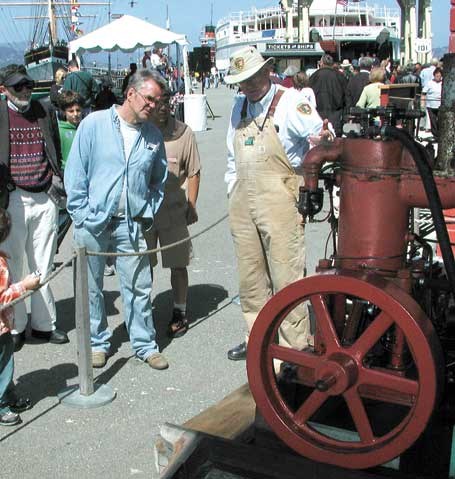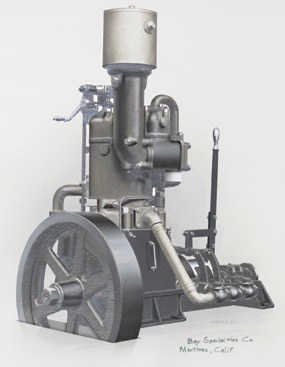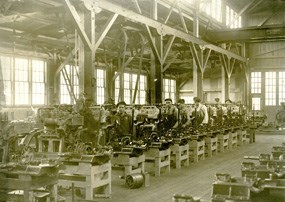
NPS Say the words "potato, potato, potato" and you will hear the sound and rhythm of a Hicks marine engine circa 1910 through 1950. Hicks Engine plans and marketing materials (SAFR 17336, HDC 1092), the Park's archival collection of over 2,850 Hicks engine fabrication blueprints, provides details about the gasoline engine used most often during the first half of the 20th century in Monterey fishing boats along San Francisco's Fisherman's Wharf, the West Coast and Pacific Basin. Location, location, location - San Francisco was an epicenter of gasoline engine manufacturing and production because of its proximity to the developing West Coast. In the first half of the 20th century, California was home to more than two dozen engine builders including Hicks Iron Works in San Francisco (Grayson, 1994). 
NPS, SAFR A12.28,689n 
NPS By 1910, Irish immigrant, James Lee Hicks, had modified and refined the single cylinder four-stroke gasoline engine for optimal reliability under marine conditions. The Hicks heavy-duty marine engine was less likely to foul from moisture and was thus extremely reliable (Prine, 2010). The smallest of the Hicks heavy-duty marine engines, single cylinder between 6 to 9 horsepower and 350-500 rpm, could weigh up to 1,700 pounds. With solid construction and simplicity in design, users viewed Hicks engines as sturdy, easy to start, durable, dependable, and economical to operate and repair because all the parts are visible, in essence, a friendly engine. Local manufacturing plants meant parts were easy to obtain. Advertisements touted the Hicks engine to fishermen as a “SURE” piece of equipment they could rely on. “Sometimes there’s a heavy sea, contrary winds--power is absolutely necessary. Your life is at stake. Your earnings depend upon how the engine works,” claimed a 1930 Hicks Engines, Heavy Duty Marine Gas Engines catalog number three, circa 1940. The Hicks engine offered the ability to be competitive in the fishing industry and the “SURE” meant the Hicks engine would reliably bring you home for supper. 
NPS SAFR 17336 HDC 1092 What happened to the Hicks Iron Works? This collection of plans with detailed specifications is an excellent source for model makers, and vintage/classic gasoline engine enthusiasts. The collection includes blueprints, assembly and price lists, a catalog and instruction manual, photographs, and illustrations of parts. Blueprint title blocks indicate the unique engine series number, part name and number, and issue date. Plans for series B, C, D, E, F, W, Sketch, AY, BY, CY, DY, EY, FY, GY, HY, KY and LY model engines, which have one to three cylinders and horsepower ranging from 6 to 45, are included. To order copy of plans, please contact the Historic Documents Department, 415-561-7030. Bibliography: Make and break ignition: YouTube clip of an operating HY 16-23hp Hicks Engine: https://www.youtube.com/watch?v=heleyhqLWwk&safety_mode=true&persist_safety_mode=1 Wikipedia: http://en.wikipedia.org/wiki/Tappet Guide to the Yuba Manufacturing Company, 1898-1957 |
Last updated: December 18, 2024
